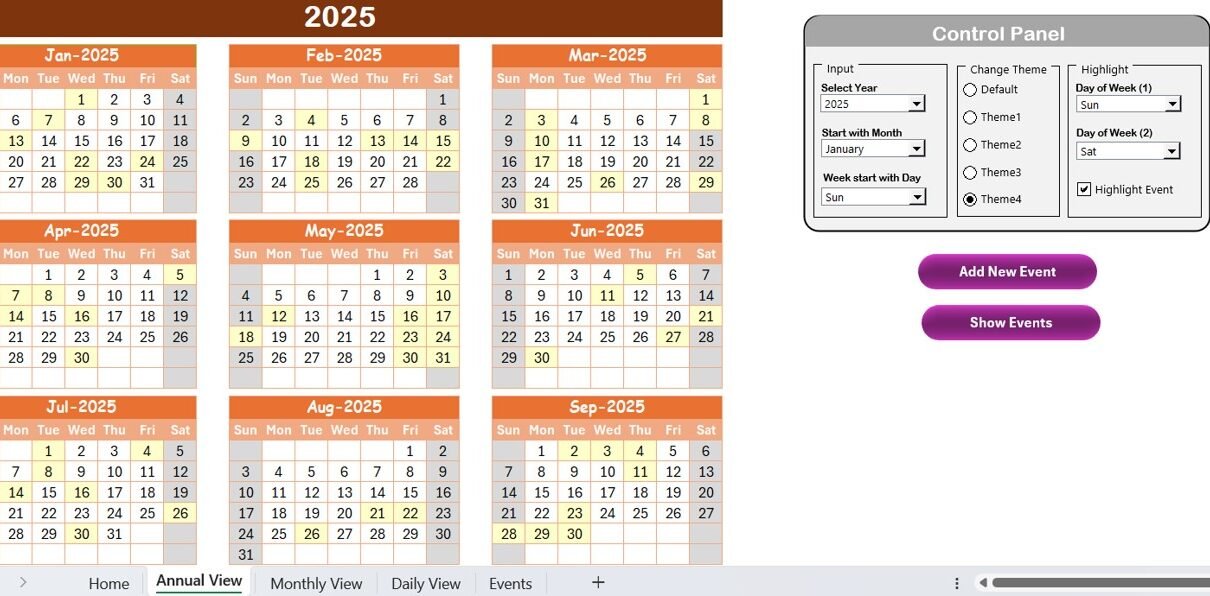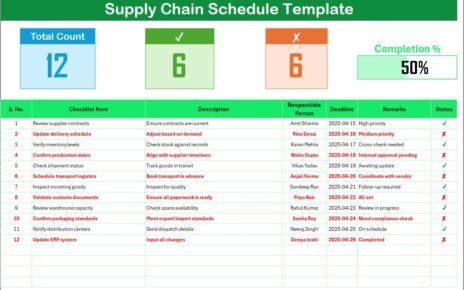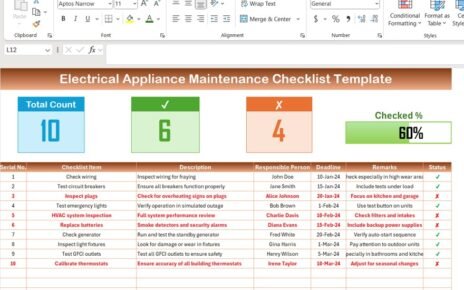In today’s fast-paced business world, you need tools that help you stay organized and ahead of the competition. One such tool is the Financial Audit Calendar in Excel. This ready-to-use calendar streamlines your audit processes and keeps your financial schedules on track. In this article, we explore every aspect of the Financial Audit Calendar in Excel, including its key features, advantages, best practices, and common challenges. We also provide a step-by-step guide to help you set up and use this powerful tool in your business.
By the end of this guide, you will have a thorough understanding of how to maximize the benefits of this calendar. Let’s dive into the details and explore why many professionals choose Excel as the backbone for managing financial audits.
Introduction
Click to buy Financial Audit
Managing financial audits involves keeping track of numerous dates, events, and deadlines. Therefore, you need a robust system that not only organizes your schedule but also offers flexibility and ease of use. The Financial Audit Calendar in Excel meets these requirements by providing a dynamic interface that lets you navigate through annual, monthly, and daily views with ease.
Moreover, you gain the freedom to customize your audit calendar based on your company’s needs. Excel’s familiar environment, coupled with this specialized calendar, creates an ideal platform for both novice and experienced professionals. As you read further, you will learn how to benefit from this tool and understand its value in simplifying your audit management tasks.
What Is a Financial Audit Calendar in Excel?
A Financial Audit Calendar in Excel is a specialized template designed to organize and display your audit schedule. It streamlines your workflow by providing separate worksheets that break down the calendar into manageable sections.
You actively control the calendar by entering key dates, setting themes, and adding events. This active management makes the calendar more than just a static schedule; it becomes an interactive tool that adapts to your evolving needs. The calendar helps you monitor important financial deadlines and ensures that you never miss a critical audit event.
Key Features and Structure
The Financial Audit Calendar in Excel comprises five essential worksheets, each designed to serve a unique purpose. Let’s explore each worksheet and how it contributes to a seamless audit process.
Home Sheet Tab
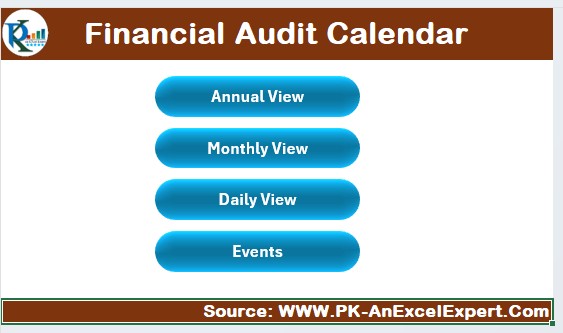
The Home Sheet tab functions as your dashboard or index page. Here, you find four main buttons that let you quickly jump to the respective sections of the calendar. These buttons include:
- Annual View Button – Navigates to a full-year calendar view.
- Monthly View Button – Opens the calendar for a selected month.
- Daily View Button – Displays detailed events for a chosen date range.
- Events Button – Provides access to the database of all scheduled events.
This intuitive design helps you start your navigation journey without confusion. By clicking on the appropriate button, you save time and increase your efficiency. The Home Sheet is your launchpad, ensuring that every feature remains within your reach.
Click to buy Financial Audit
Annual View Sheet Tab
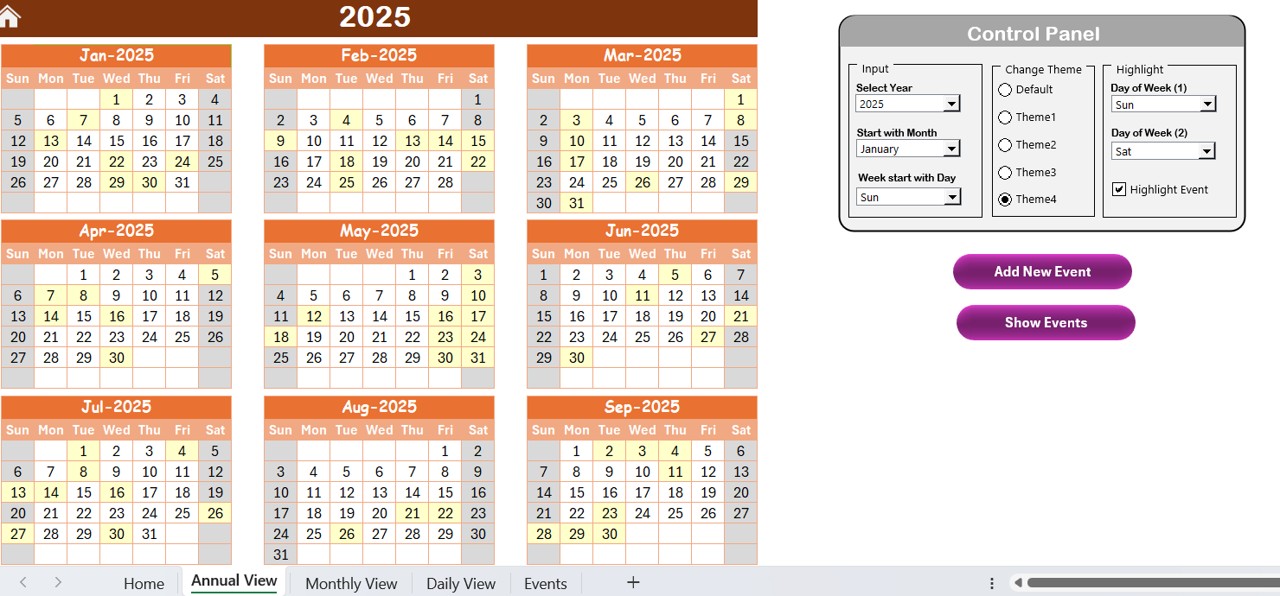
The Annual View Sheet tab showcases a comprehensive view of all 12 months. This sheet not only displays the calendar but also includes a dedicated control panel and interactive buttons.
Control Panel Features
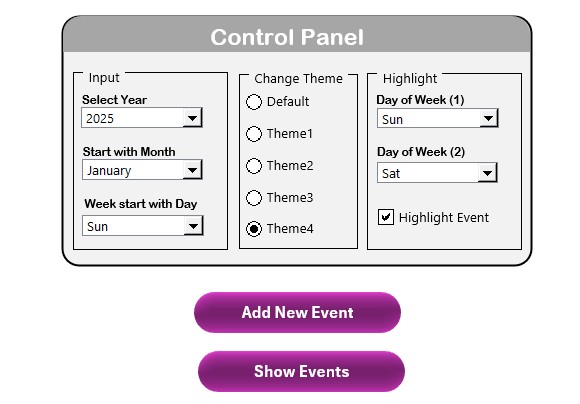
The control panel is divided into three distinct groups:
Input Group:
- Year Selection: Choose the desired year, and the calendar updates automatically.
- Starting Month: Modify the calendar’s start month to align with your business cycle.
- Starting Day of the Week: Set the first day of the week to match your organizational preference.
Change Theme Group:
Choose from five different color themes. This feature enables you to customize the look of the entire workbook, adding a touch of personalization to your audit calendar.
Highlight Group:
- Highlight Days: Select specific days (for example, Saturday and Sunday) to highlight on the calendar.
- Event Highlight: Enable the option to highlight events in a distinct color (typically yellow) so you can easily spot important dates.
Interactive Buttons
In addition to the control panel, you find two buttons that enhance your user experience:
Add New Event Button:
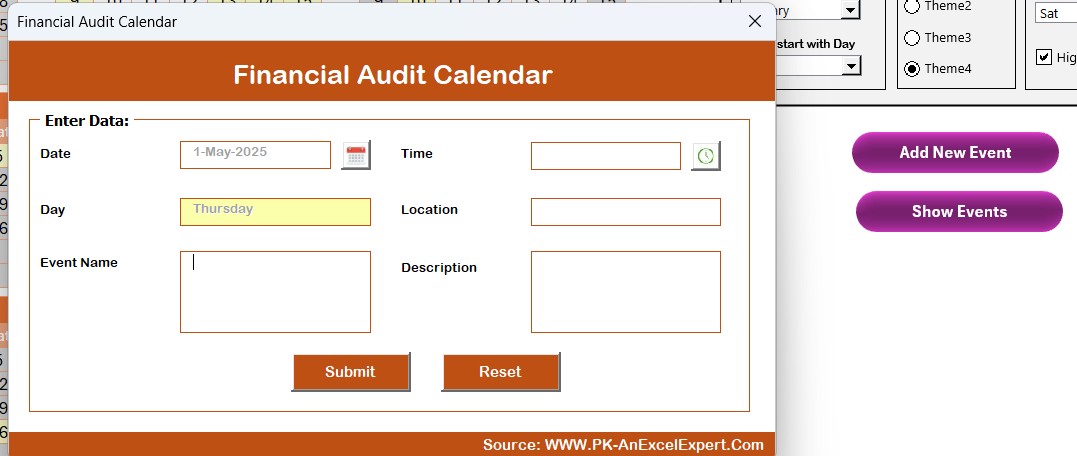
- Use this button to quickly add a new event on a specific date. The system opens a form where you fill in the necessary details and then submit the event.
- Show Event Button: Click this button to view a list of events scheduled for the selected date.
By combining these elements, the Annual View Sheet tab provides a bird’s-eye view of your financial audit schedule, making it easier to plan and execute audit tasks throughout the year.
Monthly View Sheet Tab
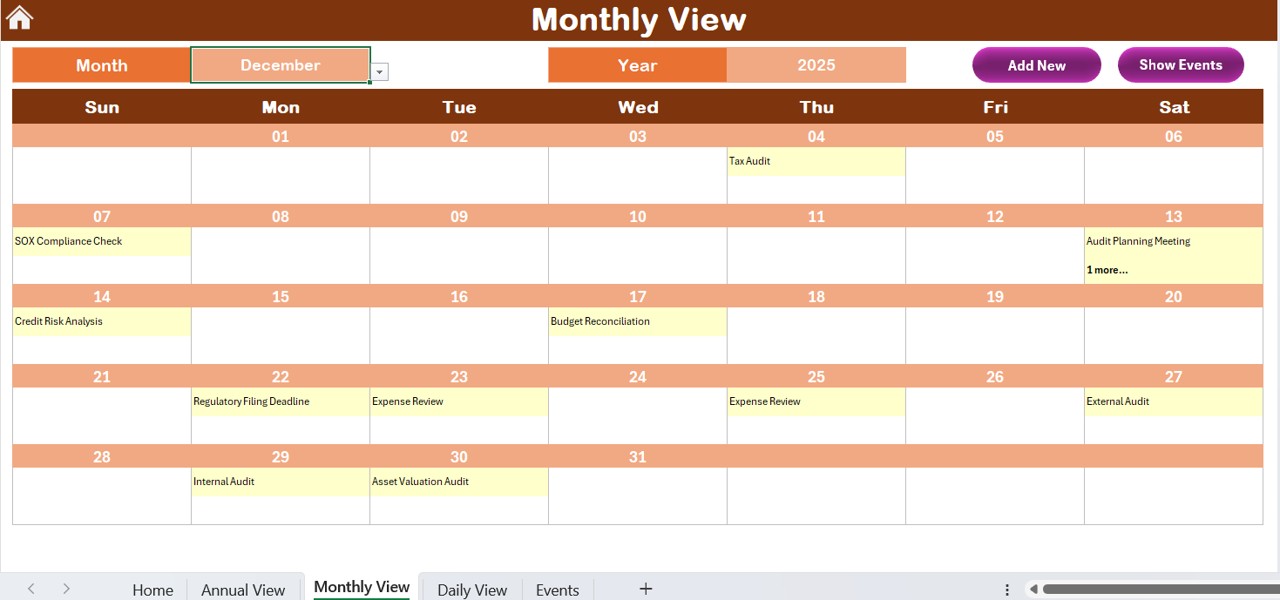
- The Monthly View Sheet tab focuses on a single month, offering a detailed calendar that simplifies event tracking for that period.
- On this sheet, you can choose the specific month and year from the top, and the calendar instantly adjusts to display relevant events. If a date contains more than one event, the system indicates “more than 1…” ensuring you can drill down further for details.
Additionally, the Monthly View includes two interactive buttons:
- Add New Event Button: Similar to the Annual View, this button allows you to add events by selecting a date and filling out the event form.
- Show Event Button: Use this button to view a detailed list of events on the chosen date.
The focus on a single month helps you manage daily activities without feeling overwhelmed by the entire year’s schedule. This view suits professionals who need to concentrate on short-term audit tasks.
Click to buy Financial Audit
Daily View Sheet Tab

The Daily View Sheet tab presents a detailed list of events over a selected date range. This sheet is particularly useful for users who need to manage specific audit tasks on a day-to-day basis.
Key features include:
- Date Range Selection: At the top, you find fields for the start and end dates. You can use the calendar icon to easily pick dates.
- Refresh Button: After selecting a date range, click the Refresh button to update the event list with the latest information.
- Add New Event Button: This button works similarly to its counterparts on the Annual and Monthly views, opening a form to add new events quickly.
By providing detailed daily views, the calendar ensures you do not overlook any crucial audit events. It gives you complete control over your schedule by allowing a focused look at your daily tasks.
Events Sheet Tab
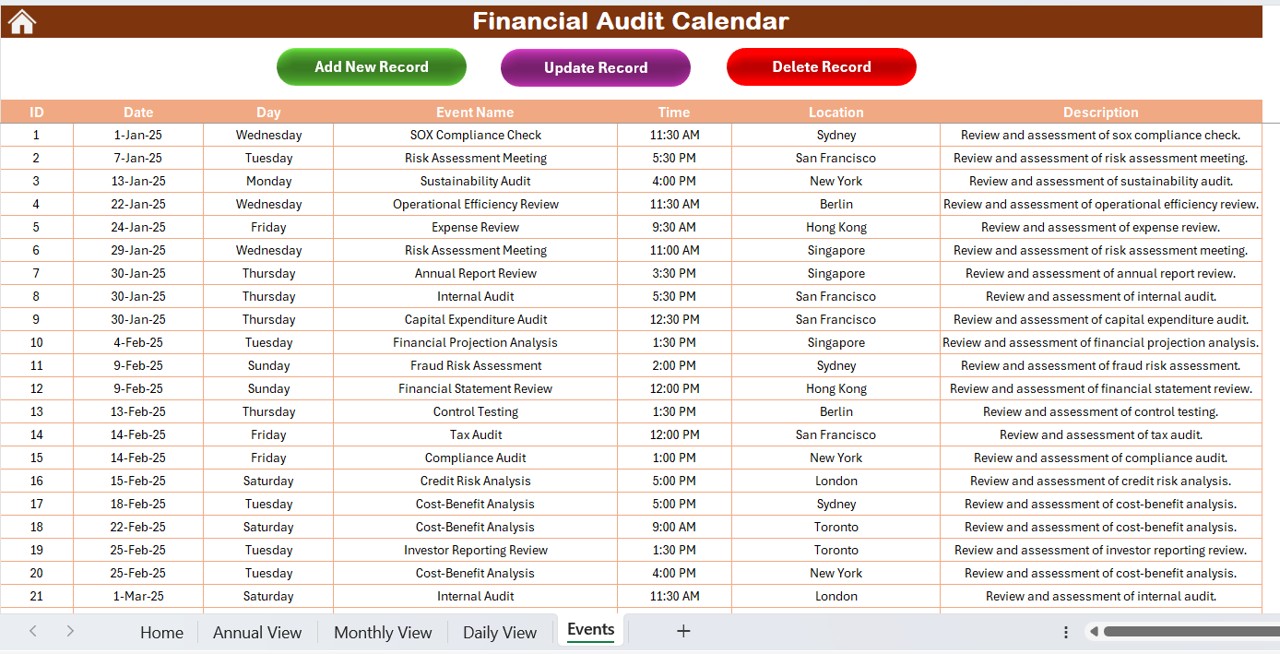
The Events Sheet tab functions as the database for all your scheduled audit events. This sheet captures detailed information and provides an excellent overview of every event. The fields include:
- ID: An auto-generated number that uniquely identifies each event.
- Date: The scheduled date of the event.
- Day: The day of the week (e.g., Sunday, Monday).
- Event Name: A brief, descriptive name for the event.
- Time: The exact time the event is scheduled.
- Location: The event’s location.
- Description: A short description that outlines the event’s details.
At the top of the Events Sheet tab, you find three buttons that let you manage the event database:
Click to buy Financial Audit
Add New Record Button:
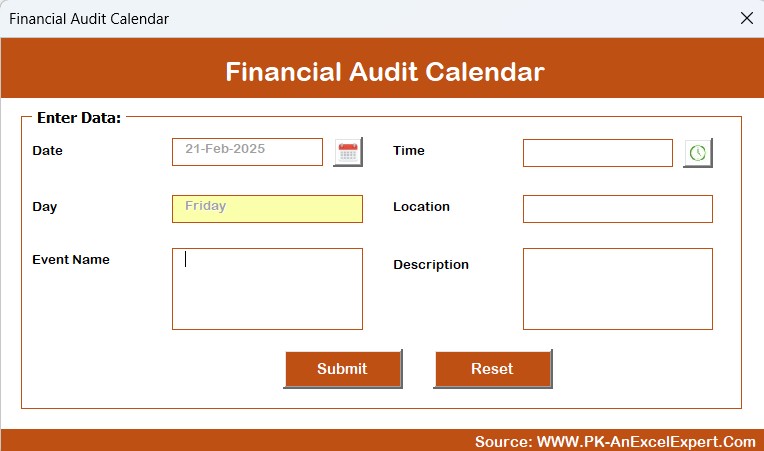
- Opens a form to input a new event into the database.
Update Existing Record Button:
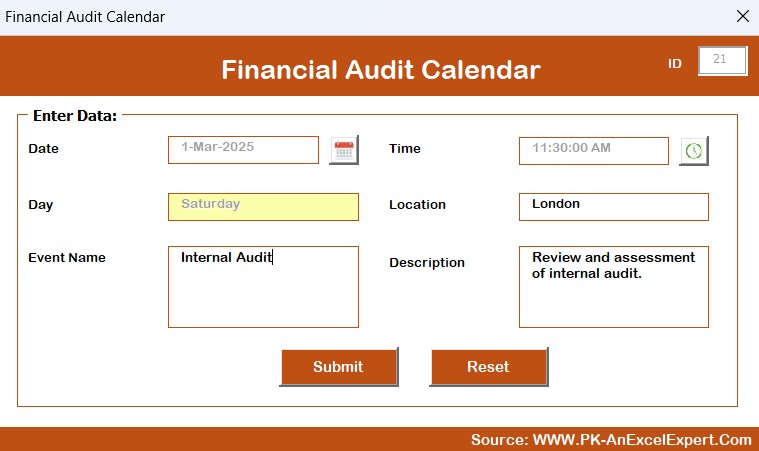
- Lets you update details of a selected event. First, choose the event by its ID, then click the button to open the pre-filled form.
- Delete Record Button: Allows you to remove an event by selecting its ID and clicking the delete option.
This worksheet plays a crucial role in managing and maintaining an organized record of all events, ensuring that you have quick access to historical data and future planning.
Advantages of a Financial Audit Calendar in Excel
Using a Financial Audit Calendar in Excel offers numerous advantages that streamline your workflow. Let’s explore these benefits in detail:
Enhanced Organization
- Centralized Management: The calendar organizes annual, monthly, and daily events in one place. You actively manage your audit events without switching between different systems.
- Intuitive Interface: With clearly labeled tabs and buttons, you quickly access the desired views. This feature helps reduce errors and saves time.
Improved Customization
- Personalized Themes: You can change the workbook’s color theme to match your company’s branding or personal preference.
- Flexible Settings: Customize the starting month and day of the week to suit your business cycle. This flexibility ensures that the calendar adapts to your unique requirements.
Best Practices for Using the Financial Audit Calendar
To make the most of your Financial Audit Calendar in Excel, consider the following best practices:
Regularly Update Your Calendar
- Daily Checks: Spend a few minutes every day to update the calendar with any new events or changes. This habit keeps your data current.
- Weekly Reviews: Conduct a weekly review to verify that all upcoming audit events are accurately recorded. Use the Annual and Monthly views for broader insights.
Customize the Calendar for Your Needs
- Adjust Settings: Modify the starting month, starting day, and color theme according to your preferences. Tailor the calendar so that it fits your workflow perfectly.
- Highlight Key Dates: Use the Highlight group in the Annual View to mark weekends and important audit dates. This visual cue helps you quickly identify critical periods.
Leverage Interactive Features
- Use the Add New Event Button: Always use the dedicated button to add new events. This process minimizes errors and ensures consistency.
- Utilize the Refresh Button: On the Daily View, click the Refresh button after making changes to see the updated event list. This practice avoids outdated information.
Maintain a Clean Database
- Regular Audits: Periodically review the Events Sheet to remove outdated or duplicate entries. A clean database improves the overall performance of the calendar.
- Backup Your Data: Save regular backups of your Excel workbook to avoid data loss. This practice protects your work against unforeseen technical issues.
Educate Your Team
- Training Sessions: Conduct short training sessions with your team on how to use the Financial Audit Calendar. When everyone understands the tool, you improve overall productivity.
- Clear Documentation: Provide documentation that outlines the steps to add, update, and delete events. Clear instructions reduce confusion and errors.
Frequently Asked Questions (FAQs) with Answers
Q1: What is a Financial Audit Calendar in Excel?
A1: A Financial Audit Calendar in Excel is a specialized template that organizes your financial audit events by offering annual, monthly, and daily views. You actively update the calendar with events, manage them easily through interactive buttons, and customize settings to match your business needs.
Q2: How do I customize the calendar’s settings?
A2: You customize the calendar by using the control panel on the Annual View sheet. You can select the year, change the starting month and day of the week, choose a color theme, and highlight key days. These adjustments make the calendar flexible and tailored to your requirements.
Q3: How do I add a new event?
A3: You add a new event by clicking the Add New Event button available on the Annual, Monthly, or Daily views. This action opens a form where you fill in details such as the date, event name, time, location, and description. After submission, the event appears on the corresponding date.
Q4: What should I do if multiple events occur on the same day?
A4: If multiple events occur on the same day, the calendar displays “more than 1…” on that date. You then click the Show Event button to view the detailed list of all events scheduled for that day, which helps you manage overlapping events efficiently.
Q5: How do I update or delete an event?
A5: To update or delete an event, navigate to the Events Sheet tab. Select the event by its unique ID, then click the Update Existing Record or Delete Record button as needed. The update process opens a form with pre-filled data, allowing you to make changes before resubmitting.
Q6: How often should I update my Financial Audit Calendar?
A6: You should update your calendar daily for new or changed events and review it weekly to ensure all information remains accurate. Regular updates prevent errors and help you stay on top of your audit schedule.
Q7: Can I share this calendar with my team?
A7: Yes, you can share the Excel workbook on a shared drive or cloud service. When your team accesses the same calendar, you improve collaboration, maintain consistency, and reduce miscommunication.
Click to buy Financial Audit
Visit our YouTube channel to learn step-by-step video tutorials
View this post on Instagram
